Definition, Epidemiology, Pathophysiology, and Essential Criteria for Diagnosis of Pediatric Chronic Myeloid Leukemia
Abstract
:Simple Summary
Abstract
1. Introduction
2. Definition of CML
3. Related Terminology and ICD Codes
4. Staging and Classification of CML by Phases
- -
- Chronic phase (CML-CP) is the most common, indolent clinical stable phase of CML lasting for several years. The myeloid cells are differentiated, with less than 10% of blast cells present in the bone marrow. The response to therapy is excellent.
- -
- If untreated, CML-CP usually progresses to the accelerated phase (CML-AP). The cells multiply aggressively and the blast cells increase to 10–19%. Additional chromosomal aberrations beside the Ph+ may be detectable [14]. The response to therapy becomes poorer.
- -
- From CML-AP the leukemia progresses to a blastic phase (CML-BP) which is indistinguishable from acute leukemia exhibiting >20% (or ≥30%, see below) of bone marrow blasts of either myeloid or lymphoid immunophenotype. The response to therapy is very poor.
- hematologic resistance to the first TKI (or failure to achieve a complete hematologic response to the first TKI) or
- any hematological, cytogenetic, or molecular indications of resistance to 2 sequential TKIs or
- occurrence of 2 or more mutations in BCR-ABL1 during TKI therapy
5. Subtypes of CML
6. Differential Diagnosis
7. Epidemiology
8. Etiology
9. Pathogenesis
10. Clinical Features and Hematological Findings
11. Rheological Problems Associated with High White Cell and Platelet Count
12. Histopathological Findings
13. Cytology/Immunophenotype
14. Diagnostic Assessments
15. Essential and Desirable Diagnostic Criteria
- -
- Full blood count with manual differential for percent of blasts, promyelocytes, eosinophils, and basophils. It should be performed before any therapy has been given and is useful to assess the correct stage of the disease and to calculate prognostic risk scores
- -
- spleen size, liver size (both in cm below the costal margin) on quiet breathing,
- -
- assessment of extramedullary manifestation of CML (lymph nodes, skin, bone, etc.),
- -
- demonstration of the Ph+ chromosome, including assessment of additional chromosomal aberrations, loss of chromosomes, derivative chromosome 9,
- -
- demonstration of the BCR-ABL1 fusion gene,
- -
- type of fusion gene transcript type as detected by RT-PCR
- (a) for optimal monitoring of treatment response in individual patients:
- (b) to compare data on pediatric CML BCR-ABL1 internationally:
- -
- a threphine biopsy (degree of fibrosis, nests of blasts),
- -
- due to the rarity of pediatric CML all patients should be enrolled in trials and enrolled into the international pediatric CML registry [4],
- -
- (c) to improve the scientific understanding of the disease:
- -
- -
- -
- -
16. Prognosis and Prediction
17. Summary and Conclusions
Author Contributions
Funding
Institutional Review Board Statement
Informed Consent Statement
Data Availability Statement
Conflicts of Interest
Disclosures
References
- Champagne, M.A.; Capdeville, R.; Krailo, M.; Qu, W.; Peng, B.; Rosamilia, M.; Therrien, M.; Zoellner, U.; Blaney, S.M.; Bernstein, M.; et al. Imatinib mesylate (STI571) for treatment of children with Philadelphia chromosome-positive leukemia: Results from a Children’s Oncology Group phase 1 study. Blood 2004, 104, 2655–2660. [Google Scholar] [CrossRef] [PubMed] [Green Version]
- Cwynarski, K.; Roberts, I.A.; Iacobelli, S.; van Biezen, A.; Brand, R.; Devergie, A.; Vossen, J.M.; Aljurf, M.; Arcese, W.; Locatelli, F.; et al. Stem cell transplantation for chronic myeloid leukemia in children. Blood 2003, 102, 1224–1231. [Google Scholar] [CrossRef] [PubMed] [Green Version]
- Suttorp, M. Innovative approaches of targeted therapy for CML of childhood in combination with paediatric haematopoietic SCT. Bone Marrow Transplant. 2008, 42 (Suppl. S2), S40–S46. [Google Scholar] [CrossRef] [Green Version]
- Suttorp, M.; Metzler, M.; Millot, F. Horn of plenty: Value of the international registry for pediatric chronic myeloid leukemia. World J. Clin Oncol. 2020, 11, 308–319. [Google Scholar] [CrossRef] [PubMed]
- Hasle, H. Myelodysplastic and myeloproliferative disorders of childhood. Hematol. Am. Soc. Hematol. Educ. Program. 2016, 2016, 598–604. [Google Scholar] [CrossRef] [Green Version]
- Nitta, M.; Kato, Y.; Strife, A.; Wachter, M.; Fried, J.; Perez, A.; Jhanwar, S.; Duigou-Osterndorf, R.; Chaganti, R.S.; Clarkson, B. Incidence of Involvement of the B and T Lymphocyte Lineages in Chronic Myelogenous Leukemia. Blood 1985, 66, 1053–1061. [Google Scholar] [CrossRef]
- Nogueira-Costa, R.; Spitzer, G.; Khorana, S.; Pham, Q.; Kantarjian, H.M.; Manning, J.T.; Ordonez, N.G.; Dicke, K.A. T-cell Involvement in Benign Phase Chronic Myelogenous Leukemia. Leuk Res. 1986, 10, 1433–1439. [Google Scholar] [CrossRef]
- Fang, B.; Zheng, C.; Liao, L.; Han, Q.; Sun, Z.; Jiang, X.; Zhao, R.C. Identification of human chronic myelogenous leukemia progenitor cells with hemangioblastic characteristics. Blood 2005, 105, 2733–2740. [Google Scholar] [CrossRef] [Green Version]
- Gunsilius, E.; Duba, H.C.; Petzer, A.L.; Kahler, C.M.; Grunewald, K.; Stockhammer, G.; Gabl, C.; Dirnhofer, S.; Clausen, J.; Gastl, G. Evidence from a leukaemia model for maintenance of vascular endothelium by bone-marrow-derived endothelial cells. Lancet 2000, 355, 1688–1691. [Google Scholar] [CrossRef]
- Otten, J.; Schultze, A.; Schafhausen, P.; Otterstetter, S.; Dierlamm, J.; Bokemeyer, C.; Brummendorf, T.H.; Fiedler, W.; Loges, S. Blood outgrowth endothelial cells from chronic myeloid leukaemia patients are BCR/ABL1 negative. Br. J. Haematol. 2008, 142, 115–118. [Google Scholar] [CrossRef] [PubMed]
- Niemeyer, C.M. JMML genomics and decisions. Hematol. Am. Soc. Hematol. Educ. Program. 2018, 2018, 307–312. [Google Scholar] [CrossRef] [PubMed] [Green Version]
- Chang, T.Y.; Dvorak, C.C.; Loh, M.L. Bedside to bench in juvenile myelomonocytic leukemia: Insights into leukemogenesis from a rare pediatric leukemia. Blood 2014, 124, 2487–2497. [Google Scholar] [CrossRef] [PubMed] [Green Version]
- Locatelli, F.; Niemeyer, C.M. How I treat juvenile myelomonocytic leukemia. Blood 2015, 125, 1083–1090. [Google Scholar] [CrossRef]
- Millot, F.; Dupraz, C.; Guilhot, J.; Suttorp, M.; Brizard, F.; Leblanc, T.; Güneş, A.M.; Sedlacek, P.; De Bont, E.; Li, C.K.; et al. Additional cytogenetic abnormalities and variant t(9;22) at the diagnosis of childhood chronic myeloid leukemia: The experience of the International Registry for Chronic Myeloid Leukemia in Children and Adolescents. Cancer 2017, 123, 3609–3616. [Google Scholar] [CrossRef] [PubMed] [Green Version]
- Arber, D.A.; Orazi, A.; Hasserjian, R.; Thiele, J.; Borowitz, M.J.; Le Beau, M.M.; Bloomfield, C.D.; Cazzola, M.; Vardiman, J.W. The 2016 revision to the World Health Organization classification of myeloid neoplasms and acute leukemia. Blood 2016, 127, 2391–2405. [Google Scholar] [CrossRef]
- Vardiman, J.W.; Pierre, R.; Thiele, J.; Imbert, M.; Brunning, R.D.; Flandrin, G. Chronic myelogenous leukaemia. In World Health Organization Classification of Tumours: Pathology and Genetics—Tumours of Haematopoietic and Lymphoid Tissues; Jaffe, E.S., Harris, N.L., Stein, H., Vardiman, J.W., Eds.; IARC Press: Lyon, France, 2016; pp. 20–26. [Google Scholar]
- Baccarani, M.; Saglio, G.; Goldman, J.; Hochhaus, A.; Simonsson, B.; Appelbaum, F.; Apperley, J.; Cervantes, F.; Cortes, J.; Deininger, M.; et al. Evolving concepts in the management of chronic myeloid leukemia: Recommendations from an expert panel on behalf of the European LeukemiaNet. Blood 2006, 108, 1809–1820. [Google Scholar] [CrossRef] [Green Version]
- Cortes, J.E.; Talpaz, M.; O’Brien, S.; Faderl, S.; Garcia-Manero, G.; Ferrajoli, A.; Verstovsek, S.; Rios, M.B.; Shan, J.; Kantarjian, H.M. Staging of chronic myeloid leukemia in the imatinib era: An evaluation of the World Health Organization proposal. Cancer 2006, 106, 1306–1315. [Google Scholar] [CrossRef]
- De la Fuente, J.; Baruchel, A.; Biondi, A.; de Bont, E.; Dresse, M.F.; Suttorp, M.; Millot, F.; International BFM Group (iBFM) Study Group Chronic Myeloid Leukaemia Committee. Managing children with chronic myeloid leukaemia (CML): Recommendations for the management of CML in children and young people up to the age of 18 years. Br. J. Haematol. 2014, 167, 33–47. [Google Scholar] [CrossRef]
- Athale, U.; Hijiya, N.; Patterson, B.C.; Bergsagel, J.; Andolina, J.R.; Bittencourt, H.; Schultz, K.R.; Burke, M.J.; Redell, M.S.; Kolb, E.A.; et al. Management of chronic myeloid leukemia in children and adolescents: Recommendations from the Children’s Oncology Group CML Working Group. Pediatr. Blood Cancer 2019, 66, e27827. [Google Scholar] [CrossRef]
- NCCN Guidelines Version 2.Chronic Myeloid Leukemia. Available online: www.nccn.org/professionals/physician_gls/pdf/cml.pdf (accessed on 3 December 2020).
- Adler, R.; Viehmann, S.; Kuhlisch, E.; Martiniak, Y.; Röttgers, S.; Harbott, J.; Suttorp, M. Correlation of BCR/ABL transcript variants with patients’ characteristics in childhood chronic myeloid leukaemia. Eur. J. Haematol. 2009, 82, 112–118. [Google Scholar] [CrossRef]
- Mughal, T.I.; Radich, J.P.; Deininger, M.W.; Apperley, J.F.; Hughes, T.P.; Harrison, C.J.; Gambacorti-Passerini, C.; Saglio, G.; Cortes, J.; Daley, G.Q. Chronic myeloid leukemia: Reminiscences and dreams. Haematologica 2016, 101, 541–558. [Google Scholar] [CrossRef] [PubMed]
- Quintás-Cardama, A.; Cortes, J. Molecular biology of bcr-abl1-positive chronic myeloid leukemia. Blood 2009, 113, 1619–1630. [Google Scholar] [CrossRef] [PubMed] [Green Version]
- Barnes, D.J.; Melo, J.V. Cytogenetic and molecular genetic aspects of chronic myeloid leukaemia. Acta Haematol. 2002, 108, 180–202. [Google Scholar] [CrossRef] [PubMed]
- Melo, J.V. The diversity of BCR-ABL fusion proteins and their relationship to leukemia phenotype. Blood 1996, 88, 2375–2384. [Google Scholar] [CrossRef] [Green Version]
- Baccarani, M.; Castagnetti, F.; Gugliotta, G.; Rosti, G.; Soverini, S.; Albeer, A.; Pfirrmann, M.; International BCR-ABL Study Group. The proportion of different BCR-ABL1 transcript types in chronic myeloid leukemia. An international overview. Leukemia 2019, 33, 1173–1183. [Google Scholar] [CrossRef]
- Demehri, S.; Paschka, P.; Schultheis, B.; Lange, T.; Koizumi, T.; Sugimoto, T.; Branford, S.; Lim, L.C.; Kegel, T.; Martinelli, G.; et al. e8aBCR-ABL: More frequent than other atypical BCR-ABL variants? Leukemia 2005, 19, 681–684. [Google Scholar] [CrossRef]
- Hochhaus, A.; Reiter, A.; Skladny, H.; Melo, J.V.; Sick, C.; Berger, U.; Guo, J.Q.; Arlinghaus, R.B.; Hehlmann, R.; Goldman, J.M.; et al. A novel BCR-ABL fusion gene (e6a2) in a patient with Philadelphia chromosome-negative chronic myelogenous leukemia. Blood 1996, 88, 2236–2240. [Google Scholar] [CrossRef] [Green Version]
- Van der Velden, V.H.; Beverloo, H.B.; Hoogeveen, P.G.; Zwaan Ch, M. A novel BCR-ABL fusion transcript (e18a2) in a child with chronic myeloid leukemia. Leukemia 2007, 21, 833–835. [Google Scholar] [CrossRef] [PubMed] [Green Version]
- Mandal, P.; Mukherjee, S.B. Leukemoid Reaction—A Tale of Years. Indian Pediatr. 2015, 52, 973–974. [Google Scholar] [CrossRef]
- Sakka, V.; Tsiodras, S.; Giamarellos-Bourboulis, E.J.; Giamarellou, H. An update on the etiology and diagnostic evaluation of a leukemoid reaction. Eur. J. Intern. Med. 2006, 17, 394–398. [Google Scholar] [CrossRef]
- Hoofien, A.; Yarden-Bilavski, H.; Ashkenazi, S.; Chodick, G.; Livni, G. Leukemoid reaction in the pediatric population: Etiologies, outcome, and implications. Eur. J. Pediatr. 2018, 177, 1029–1036. [Google Scholar] [CrossRef]
- Karow, A.; Nienhold, R.; Lundberg, P.; Peroni, E.; Putti, M.C.; Randi, M.L.; Skoda, R.C. Mutational profile of childhood myeloproliferative neoplasms. Leukemia 2015, 29, 2407–2409. [Google Scholar] [CrossRef]
- Sekhar, M.; Prentice, H.G.; Popat, U.; Anderson, D.; Janmohammed, R.; Roberts, I.; Britt, R.P. Idiopathic myelofibrosis in children. Br. J. Haematol. 1996, 93, 394–397. [Google Scholar] [CrossRef]
- Ding, N.; Zhang, Z.; Yang, W.; Ren, L.; Zhang, Y.; Zhang, J.; Li, Z.; Zhang, P.; Zhu, X.; Chen, X.; et al. Transcriptome Analysis of Monozygotic Twin Brothers with Childhood Primary Myelofibrosis. Genom. Proteom. Bioinform. 2017, 15, 37–48. [Google Scholar] [CrossRef] [PubMed]
- Mitton, B.; de Oliveira, S.; Pullarkat, S.T.; Moore, T.B. Stem cell transplantation in primary myelofibrosis of childhood. J. Pediatr. Hematol. Oncol. 2013, 35, e120–e122. [Google Scholar] [CrossRef] [PubMed] [Green Version]
- Kratz, C.P.; Franke, L.; Peters, H.; Kohlschmidt, N.; Kazmierczak, B.; Finckh, U.; Bier, A.; Eichhorn, B.; Blank, C.; Kraus, C.; et al. Cancer spectrum and frequency among children with Noonan, Costello, and cardio-facio-cutaneous syndromes. Br. J. Cancer 2015, 112, 1392–1397. [Google Scholar] [CrossRef] [PubMed] [Green Version]
- Swerdlow, S.H.; Campo, E.; Harris, N.L.; Jaffe, E.S.; Pileri, S.A.; Stein, H.; Thiele, J.; Arber, D.A.; Hasserjian, R.P.; Le Beau, M.M.; et al. (Eds.) WHO Classification of Tumours of Haematopoietic and Lymphoid Tissues; IARC Press: Lyon, France, 2017. [Google Scholar]
- Malhotra, H.; Radich, J.; Garcia-Gonzalez, P. Meeting the Needs of CML Patients in Resource-Poor Countries. Hematol. Am. Soc. Hematol. Educ. Program 2019, 2019, 433–442. [Google Scholar] [CrossRef] [PubMed]
- National Cancer Institute. Cancer Stat Facts: Leukemia—Chronic Myeloid Leukemia (CML). 2018. Available online: https://seer.cancer.gov/statfacts/html/cmyl.html. (accessed on 3 December 2020).
- Wang, A.; Wang, Y.; Yao, Y.; Xu, Z.; Zhou, L.; Wang, L.; Zhang, L.; Chen, Y.; Shen, Z.; Hu, J.; et al. Summary of 615 patients of chronic myeloid leukemia in Shanghai from 2001 to 2006. J. Exp. Clin. Cancer Res. 2010, 29, 20. [Google Scholar] [CrossRef] [PubMed] [Green Version]
- Tanizawa, A. Optimal management for pediatric CML. Pediatrics Int. 2016, 58, 171–179. [Google Scholar] [CrossRef]
- Meral Günes, A.; Millot, F.; Kalwak, K.; Lausen, B.; Sedlacek, P.; de Bruijn, C.A.M.; Dworzak, M.; de Moerloose, B.; Suttorp, M. Features and Outcome of Chronic Myeloid Leukemia at Very Young Age – Data from the International Pediatric CML Registry (I-CML-Ped Study). Ped Blood Cancer 2021, 68, e28706. [Google Scholar] [CrossRef]
- Available online: https://seer.cancer.gov/archive/csr/1975_2015/results_merged/sect_29_childhood_cancer_iccc.pdf (accessed on 1 August 2020).
- Alsop, S.; Sanger, W.G.; Elenitoba-Johnson, K.S.; Lim, M.S. Chronic myeloid leukemia as a secondary malignancy after ALK-positive anaplastic large cell lymphoma. Hum Pathol. 2007, 38, 1576–1580. [Google Scholar] [CrossRef] [PubMed]
- Bauduer, F.; Ducout, L.; Dastugue, N.; Marolleau, J.P. Chronic myeloid leukemia as a secondary neoplasm after anti-cancer radiotherapy: A report of three cases and a brief review of the literature. Leuk Lymphoma 2002, 43, 1057–1060. [Google Scholar] [CrossRef] [PubMed]
- Millett, R.; Aggarwal, A.; Tabbara, I.; Nassereddine, S. Chronic Myeloid Leukemia as Secondary Malignancy Following the Treatment of Hodgkin Lymphoma: A Case Series. Anticancer Res. 2019, 39, 4333–4335. [Google Scholar] [CrossRef] [PubMed]
- Zahra, K.; Ben Fredj, W.; Ben Youssef, Y.; Zaghouani, H.; Chebchoub, I.; Zaier, M.; Badreddine, S.; Braham, N.; Sennana, H.; Khelif, A. Chronic myeloid leukemia as a secondary malignancy after lymphoma in a child. A case report and review of the literature. Onkologie 2012, 35, 690–693. [Google Scholar] [CrossRef] [PubMed]
- Bizzozero, O.J., Jr.; Johnson, K.G.; Ciocco, A. Radiation-related leukemia in Hiroshima and Nagasaki, 1946-I. Distribution, incidence and appearance time. N. Engl. J. Med. 1966, 274, 1095–1101. [Google Scholar] [CrossRef] [PubMed]
- Corso, A.; Lazzarino, M.; Morra, E.; Merante, S.; Astori, C.; Bernasconi, P.; Boni, M.; Bernasconi, C. Chronic myelogenous leukemia and exposure to ionizing radiation--a retrospective study of 443 patients. Ann. Hematol. 1995, 70, 79–82. [Google Scholar] [CrossRef]
- Finch, S.C.; Linet, M.S. Chronic Leukaemias. Baillieres Clin Haematol. 1992, 5, 27–56. [Google Scholar] [CrossRef]
- Radivoyevitch, T.; Jankovic, G.M.; Tiu, R.V.; Saunthararajah, Y.; Jackson, R.C.; Hlatky, L.R.; Gale, R.P.; Sachs, R.K. Sex differences in the incidence of chronic myeloid leukemia. Radiat. Environ. Biophys. 2014, 53, 55–63. [Google Scholar] [CrossRef] [Green Version]
- Ernst, T.; Busch, M.; Rinke, J.; Ernst, J.; Haferlach, C.; Beck, J.F.; Hochhaus, A.; Gruhn, B. Frequent ASXL1 mutations in children and young adults with chronic myeloid leukemia. Leukemia 2018, 32, 2046–2049. [Google Scholar] [CrossRef]
- Togasaki, E.; Takeda, J.; Yoshida, K.; Shiozawa, Y.; Takeuchi, M.; Oshima, M.; Saraya, A.; Iwama, A.; Yokote, K.; Sakaida, E.; et al. Frequent somatic mutations in epigenetic regulators in newly diagnosed chronic myeloid leukemia. Blood Cancer J. 2017, 7, e559. [Google Scholar] [CrossRef]
- Deininger, M.W.; Goldman, J.M.; Melo, J.V. The molecular biology of chronic myeloid leukemia. Blood 2000, 96, 3343–3356. [Google Scholar] [CrossRef]
- Branford, S.; Wang, P.; Yeung, D.T.; Thomson, D.; Purins, A.; Wadham, C.; Shahrin, N.H.; Marum, J.E.; Nataren, N.; Parker, W.T.; et al. Integrative genomic analysis reveals cancer-associated mutations at diagnosis of CML in patients with high-risk disease. Blood 2018, 132, 948–961. [Google Scholar] [CrossRef]
- Shanmuganathan, N.; Branford, S. The Hidden Pathogenesis of CML: Is BCR-ABL1 the First Event? Curr. Hematol. Malig. Rep. 2019, 14, 501–506. [Google Scholar] [CrossRef] [PubMed]
- Krumbholz, M.; Karl, M.; Tauer, J.T.; Thiede, C.; Rascher, W.; Suttorp, M.; Metzler, M. Genomic BCR-ABL1 breakpoints in pediatric chronic myeloid leukemia. Genes Chromosomes Cancer 2012, 51, 1045–1053. [Google Scholar] [CrossRef]
- Greaves, M.F.; Maia, A.T.; Wiemels, J.L.; Ford, A.M. Leukemia in twins: Lessons in natural history. Blood. 2003, 102, 2321–2333. [Google Scholar] [CrossRef] [PubMed]
- Greaves, M. A causal mechanism for childhood acute lymphoblastic leukaemia. Nat. Rev. Cancer 2018, 18, 471–484. [Google Scholar] [CrossRef]
- Abecasis, M.; Cross, N.C.P.; Brito, M.; Ferreira, I.; Sakamoto, K.M.; Hijiya, N.; Score, J.; Gale, R.P. Is cancer latency an outdated concept? Lessons from chronic myeloid leukemia. Leukemia 2020, 34, 2279–2284. [Google Scholar] [CrossRef]
- Krumbholz, M.; Goerlitz, K.; Albert, C.; Lawlor, J.; Suttorp, M.; Metzler, M. Large amplicon droplet digital PCR for DNA-based monitoring of pediatric chronic myeloid leukaemia. J. Cell Mol. Med. 2019, 23, 4955–4961. [Google Scholar] [CrossRef] [Green Version]
- Score, J.; Calasanz, M.J.; Ottman, O.; Pane, F.; Yeh, R.F.; Sobrinho-Simões, M.A.; Kreil, S.; Ward, D.; Hidalgo-Curtis, C.; Melo, J.V.; et al. Analysis of genomic breakpoints in p190 and pBCR-ABL indicate distinct mechanisms of formation. Leukemia 2010, 24, 1742–1750. [Google Scholar] [CrossRef] [Green Version]
- Kuan, J.W.; Su, A.T.; Leong, C.F.; Osato, M.; Sashida, G. Systematic Review of Normal Subjects Harbouring BCR-ABLFusion Gene. Acta Haematol. 2020, 143, 96–111. [Google Scholar] [CrossRef] [PubMed]
- Branford, S.; Kim, D.D.H.; Apperley, J.F.; Eide, C.A.; Mustjoki, S.; Ong, S.T.; Nteliopoulos, G.; Ernst, T.; Chuah, C.; Gambacorti-Passerini, C.; et al. Laying the foundation for genomically-based risk assessment in chronic myeloid leukemia. Leukemia 2019, 33, 1835–1850. [Google Scholar] [CrossRef]
- Holyoake, T.L.; Vetrie, D. The chronic myeloid leukemia stem cell: Stemming the tide of persistence. Blood 2017, 129, 1160–1595. [Google Scholar] [CrossRef]
- Perrotti, D.; Silvestri, G.; Stramucci, L.; Yu, J.; Trotta, R. Cellular and Molecular Networks in Chronic Myeloid Leukemia: The Leukemic Stem, Progenitor and Stromal Cell Interplay. Curr. Drug Targets 2017, 18, 377–388. [Google Scholar] [CrossRef] [PubMed]
- Millot, F.; Traore, P.; Guilhot, J.; Nelken, B.; Leblanc, T.; Leverger, G.; Plantaz, D.; Bertrand, Y.; Bordigoni, P.; Guilhot, F. Clinical and biological features at diagnosis in 40 children with chronic myeloid leukemia. Pediatrics 2005, 116, 140–143. [Google Scholar] [CrossRef] [PubMed]
- Suttorp, M.; Schulze, P.; Glauche, I.; Göhring, G.; von Neuhoff, N.; Metzler, M.; Sedlacek, P.; de Bont, E.S.J.M.; Balduzzi, A.; Lausen, B.; et al. Front-line imatinib treatment in children and adolescents with chronic myeloid leukemia: Results from a phase III trial. Leukemia 2018, 32, 1657–1669. [Google Scholar] [CrossRef] [PubMed]
- Kalmanti, L.; Saussele, S.; Lauseker, M.; Proetel, U.; Müller, M.C.; Hanfstein, B.; Schreiber, A.; Fabarius, A.; Pfirrmann, M.; Schnittger, S.; et al. Younger patients with chronic myeloid leukemia do well in spite of poor prognostic indicators: Results from the randomized CML study IV. Ann. Hematol. 2014, 93, 71–80. [Google Scholar] [CrossRef] [Green Version]
- Millot, F.; Guilhot, J.; Suttorp, M.; Güneş, A.M.; Sedlacek, P.; De Bont, E.; Li, C.K.; Kalwak, K.; Lausen, B.; Culic, S.; et al. Prognostic discrimination based on the EUTOS long-term survival score within the International Registry for Chronic Myeloid Leukemia in children and adolescents. Haematologica 2017, 102, 1704–1708. [Google Scholar] [CrossRef] [PubMed] [Green Version]
- Suttorp, M.; Knöfler, R.; Deutsch, H.; Paul, F.; Tiebel, O.; Metzler, M.; Millot, F. High Platelet Counts, Thrombosis, Bleeding Signs, and Acquired Von Willebrand Syndrome at Diagnosis of Pediatric Chronic Myeloid Leukemia (Abstract). Blood 2019, 134 (Suppl. S1), 4152. [Google Scholar] [CrossRef]
- Millot, F.; Maledon, N.; Guilhot, J.; Güneş, A.M.; Kalwak, K.; Suttorp, M. Favourable outcome of de novo advanced phases of childhood chronic myeloid leukaemia. Eur. J. Cancer. 2019, 115, 17–23. [Google Scholar] [CrossRef] [PubMed]
- Hijiya, N.; Millot, F.; Suttorp, M. Chronic myeloid leukemia in children: Clinical findings, management, and unanswered questions. Pediatr. Clin North Am. 2015, 62, 107–119. [Google Scholar] [CrossRef]
- Millot, F.; Facon, T.; Kerckaert, J.P.; Fenaux, P.; Lai, J.L.; Parent, M.; Bauters, F.; Jouet, J.P. Unusual recurrence of chronic myelogenous leukemia following bone marrow transplantation. Bone Marrow Transpl. 1991, 7, 393–395. [Google Scholar]
- Magdy, M.; Abdel Karim, N.; Eldessouki, I.; Gaber, O.; Rahouma, M.; Ghareeb, M. Myeloid Sarcoma. Oncol. Res. Treat. 2019, 42, 224–229. [Google Scholar] [CrossRef]
- Meyran, D.; Petit, A.; Guilhot, J.; Suttorp, M.; Sedlacek, P.; De Bont, E.; Li, C.K.; Kalwak, K.; Lausen, B.; Culic, S.; et al. Lymphoblastic predominance of blastic phase in children with chronic myeloid leukemia (CML) treated with imatinib: A report from the I-CML-Ped Study. Eur. J. Cancer 2020, 137, 224–234. [Google Scholar] [CrossRef]
- Millot, F.; Baruchel, A.; Guilhot, J.; Petit, A.; Leblanc, T.; Bertrand, Y.; Mazingue, F.; Lutz, P.; Vérité, C.; Berthou, C.; et al. Imatinib is effective in children with previously untreated chronic myelogenous leukemia in early chronic phase: Results of the French national phase IV trial. J. Clin. Oncol. 2011, 29, 2827–2832. [Google Scholar] [CrossRef] [PubMed] [Green Version]
- Castagnetti, F.; Gugliotta, G.; Baccarani, M.; Breccia, M.; Specchia, G.; Levato, L.; Abruzzese, E.; Rossi, G.; Iurlo, A.; Martino, B.; et al. Differences among young adults, adults and elderly chronic myeloid leukemia patients. Ann. Oncol. 2015, 26, 185–192. [Google Scholar] [CrossRef]
- Knöfler, R.; Lange, B.S.; Paul, F.; Tiebel, O.; Suttorp, M. Bleeding signs due to acquired von Willebrand syndrome at diagnosis of chronic myeloid leukaemia in children. Br. J. Haematol. 2020, 188, 701–706. [Google Scholar] [CrossRef] [PubMed]
- Chauhan, R.; Sazawal, S.; Singh, K.; Ragesh RNair, R.; Chhikara, S.; Deka, R.; Chaubey, R.; Veetil, K.K.; Dange, P.; Mahapatra, M.; et al. Reversal of Glanzmann thrombasthenia platelet phenotype after imatinib treatment in a pediatric chronic myeloid leukemia patient. Platelets 2018, 29, 203–206. [Google Scholar] [CrossRef]
- Kurosawa, H.; Tanizawa, A.; Tono, C.; Watanabe, A.; Shima, H.; Ito, M.; Yuza, Y.; Hotta, N.; Muramatsu, H.; Okada, M.; et al. Leukostasis in Children and Adolescents with Chronic Myeloid Leukemia: Japanese Pediatric Leukemia/Lymphoma Study Group. Pediatr. Blood Cancer 2016, 63, 406–411. [Google Scholar] [CrossRef] [PubMed]
- Chen, B.; Yan, X.; Zhang, X.; Yang, H. Leukostasis Retinopathy: An Uncommon Visual Threatening Complication of Chronic Myeloid Leukemia with Severe Hyperleukocytosis - A Case Report and Review of the Literature. Ind. J. Ophthalmol. 2018, 66, 1871–1874. [Google Scholar]
- Becerra-Pedraza, L.C.; Jiménez-Martínez, L.E.; Peña-Morfin, I.; Nava-Esquivel, R.; Villegas-Martínez, J.A. Priapism as the initial sign in hematologic disease: Case report and literature review. Int. J. Surg. Case Rep. 2018, 43, 13–17. [Google Scholar] [CrossRef] [PubMed]
- Rodgers, R.; Latif, Z.; Copland, M. How I manage priapism in chronic myeloid leukaemia patients. Br. J. Haematol. 2012, 158, 155–164. [Google Scholar] [CrossRef]
- Sachdeva, P.; Kalra, M.; Thatikonda, K.B.; Aggarwal, S.K.; Sachdeva, D.; Sachdeva, A. Stuttering Priapism in a Teenage Boy: Lesson to be Learnt. J. Pediatr. Hematol. Oncol. 2020. Epub ahead of print. [Google Scholar] [CrossRef] [PubMed]
- Acar, G.O.; Acioğlu, E.; Enver, O.; Ar, C.; Sahin, S. Unilateral sudden hearing loss as the first sign of chronic myeloid leukemia. Eur. Arch. Otorhinolaryngol. 2007, 264, 1513–1516. [Google Scholar] [CrossRef] [PubMed]
- Giagounidis, A.A.; Burk, M.; Meckenstock, G.; Koch, A.J.; Schneider, W. Pathologic rupture of the spleen in hematologic malignancies: Two additional cases. Ann. Hematol. 1996, 73, 297–302. [Google Scholar] [CrossRef] [PubMed]
- Drummond, D.; Lenoir, M.; Petit, A.Y. Splenic infarction in a child revealing chronic myeloid leukemia. Eur. J. Pediatr. 2012, 171, 1141–1142. [Google Scholar] [CrossRef] [PubMed]
- Valent, P.; Horny, H.P.; Arock, M. The Underestimated Role of Basophils in Ph + Chronic Myeloid Leukaemia. Eur. J. Clin. Invest. 2018, 48, e13000. [Google Scholar] [CrossRef] [PubMed] [Green Version]
- Weil, S.C.; Hrisinko, M.A. A hybrid eosinophilic-basophilic granulocyte in chronic granulocytic leukemia. Am. J. Clin. Pathol. 1987, 87, 66–70. [Google Scholar] [CrossRef] [PubMed]
- Shinar, E.; Gershon, Z.L.; Leiserowitz, R.; Matzner, Y.; Yatziv, S.; Polliack, A. Coexistence of Gaucher disease and Philadelphia positive chronic granulocytic leukemia. Am. J. Hematol. 1982, 12, 199–202. [Google Scholar] [CrossRef]
- Hussein, K.; Stucki-Koch, A.; Göhring, G.; Kreipe, H.; Suttorp, M. Increased megakaryocytic proliferation, pro-platelet deposition and expression of fibrosis-associated factors in children with chronic myeloid leukaemia with bone marrow fibrosis. Leukemia 2017, 31, 1540–1546. [Google Scholar] [CrossRef] [PubMed]
- Dotti, G.; Garattini, E.; Borleri, G.; Masuhara, K.; Spinelli, O.; Barbui, T.; Rambaldi, A. Leucocyte alkaline phosphatase identifies terminally differentiated normal neutrophils and its lack in chronic myelogenous leukaemia is not dependent on p210 tyrosine kinase activity. Br. J. Haematol. 1999, 105, 163–172. [Google Scholar] [CrossRef]
- Rambaldi, A.; Terao, M.; Bettoni, S.; Bassan, R.; Battista, R.; Barbui, T.; Garattini, E. Differences in the expression of alkaline phosphatase mRNA in chronic myelogenous leukemia and. paroxysmal nocturnal hemoglobinuria polymorphonuclear leukocytes. Blood 1989, 73, 1113–1115. [Google Scholar] [CrossRef]
- Reid, A.G.; De Melo, V.A.; Elderfield, K.; Clark, I.; Marin, D.; Apperley, J.; Naresh, K.N. Phenotype of blasts in chronic myeloid leukemia in blastic phase—Analysis of bone marrow trephine biopsies and correlation with cytogenetics. Leuk. Res. 2009, 33, 418–425. [Google Scholar] [CrossRef]
- Advani, S.H.; Malhotra, H.; Kadam, P.R.; Iyer, R.S.; Nanjangud, G.; Balsara, B.; Saikia, T.; Gopal, R.; Nair, C.N. T-lymphoid blast crisis in chronic myeloid leukemia. Am. J. Hematol. 1991, 36, 86–92. [Google Scholar] [CrossRef]
- Qing, X.; Qing, A.; Ji, P.; French, S.W.; Mason, H. Mixed phenotype (T/B/myeloid) extramedullary blast crisis as an initial presentation of chronic myelogenous leukemia. Exp. Mol. Pathol. 2018, 104, 130–133. [Google Scholar] [CrossRef]
- Hochhaus, A.; Baccarani, M.; Silver, R.T.; Schiffer, C.; Apperley, J.F.; Cervantes, F.; Clark, R.E.; Cortes, J.E.; Deininger, M.W.; Guilhot, F.; et al. European LeukemiaNet 2020 recommendations for treating chronic myeloid leukemia. Leukemia 2020, 34, 966–984. [Google Scholar] [CrossRef] [Green Version]
- Radich, J.P.; Deininger, M.; Abboud, C.N.; Altman, J.K.; Berman, E.; Bhatia, R.; Bhatnagar, B.; Curtin, P.; DeAngelo, D.J.; Gotlib, J.; et al. Chronic Myeloid Leukemia, Version 1.2019, NCCN Clinical Practice Guidelines in Oncology. J. Natl. Compr. Canc. Netw. 2018, 16, 1108–1135. [Google Scholar] [CrossRef] [PubMed]
- Buesche, G.; Hehlmann, R.; Hecker, H.; Heimpel, H.; Heinze, B.; Schmeil, A.; Pfirrmann, M.; Gomez, G.; Tobler, A.; Herrmann, H.; et al. Marrow fibrosis, indicator of therapy failure in chronic myeloid leukemia—Prospective long-term results from a randomized-controlled trial. Leukemia 2003, 17, 2444–2453. [Google Scholar] [CrossRef] [PubMed] [Green Version]
- Buesche, G.; Ganser, A.; Schlegelberger, B.; von Neuhoff, N.; Gadzicki, D.; Hecker, H.; Bock, O.; Frye, B.; Kreipe, H. Marrow fibrosis and its relevance during imatinib treatment of chronic myeloid leukemia. Leukemia 2007, 21, 2420–2427. [Google Scholar] [CrossRef] [Green Version]
- Hidalgo-Lόpez, J.E.; Kanagal-Shamanna, R.; Quesada, A.E.; Gong, Z.; Wang, W.; Hu, S.; Medeiros, L.J.; Bassett RLJr d’Orcy, E.; Yin, C.C.; Cortes, J.; et al. Bone marrow core biopsy in 508 consecutive patients with chronic myeloid leukemia: Assessment of potential value. Cancer 2018, 124, 3849–3855. [Google Scholar] [CrossRef] [Green Version]
- Luu, M.H.; Press, R.D. BCR-ABL PCR testing in chronic myelogenous leukemia: Molecular diagnosis for targeted cancer therapy and monitoring. Expert Rev. Mol. Diagn. 2013, 13, 749–762. [Google Scholar] [CrossRef] [PubMed]
- Burmeister, T.; Reinhardt, R. A multiplex PCR for improved detection of typical and atypical BCR-ABL fusion transcripts. Leuk Res. 2008, 32, 579–585. [Google Scholar] [CrossRef]
- Möbius, S.; Schenk, T.; Himsel, D.; Maier, J.; Franke, G.N.; Saussele, S.; Pott, C.; Andrikovics, H.; Meggyesi, N.; Machova-Polakova, K.; et al. Results of the European survey on the assessment of deep molecular response in chronic phase CML patients during tyrosine kinase inhibitor therapy (EUREKA registry). J. Cancer Res. Clin. Oncol. 2019, 145, 1645–1650. [Google Scholar] [CrossRef] [PubMed] [Green Version]
- Suttorp, M.; Bornhäuser, M.; Metzler, M.; Millot, F.; Schleyer, E. Pharmacology and pharmacokinetics of imatinib in pediatric patients. Expert Rev. Clin. Pharmacol. 2018, 11, 219–231. [Google Scholar] [CrossRef]
- Cumbo, C.; Impera, L.; Minervini, C.F.; Orsini, P.; Anelli, L.; Zagaria, A.; Coccaro, N.; Tota, G.; Minervini, A.; Casieri, P.; et al. Genomic BCR-ABL1 breakpoint characterization by a multi-strategy approach for “personalized monitoring” of residual disease in chronic myeloid leukemia patients. Oncotarget 2018, 9, 10978–10986. [Google Scholar] [CrossRef] [PubMed] [Green Version]
- Machova Polakova, K.; Zizkova, H.; Zuna, J.; Motlova, E.; Hovorkova, L.; Gottschalk, A.; Glauche, I.; Koblihova, J.; Pecherkova, P.; Klamova, H.; et al. Analysis of chronic myeloid leukaemia during deep molecular response by genomic PCR: A traffic light stratification model with impact on treatment-free remission. Leukemia 2020, 34, 2113–2124. [Google Scholar] [CrossRef]
- Pagani, I.S.; Dang, P.; Kommers, I.O.; Goyne, J.M.; Nicola, M.; Saunders, V.A.; Braley, J.; White, D.L.; Yeung, D.T.; Branford, S.; et al. BCR-ABL1 genomic DNA PCR response kinetics during first-line imatinib treatment of chronic myeloid leukemia. Haematologica 2018, 103, 2026–2032. [Google Scholar] [CrossRef] [Green Version]
- Soverini, S.; de Benedittis, C.; Mancini, M.; Martinelli, G. Mutations in the BCR-ABLKinase Domain and Elsewhere in Chronic Myeloid Leukemia. Clin. Lymphoma Myeloma Leuk. 2015, 15, S120–S128. [Google Scholar] [CrossRef] [PubMed]
- Branford, S.; Fletcher, L.; Cross, N.C.; Müller, M.C.; Hochhaus, A.; Kim, D.W.; Radich, J.P.; Saglio, G.; Pane, F.; Kamel-Reid, S.; et al. Desirable performance characteristics for BCR-ABL measurement on an international reporting scale to allow consistent interpretation of individual patient response and comparison of response rates between clinical trials. Blood 2008, 112, 3330–3338. [Google Scholar] [CrossRef] [PubMed]
- Müller, M.C.; Cross, N.C.; Erben, P.; Schenk, T.; Hanfstein, B.; Ernst, T.; Hehlmann, R.; Branford, S.; Saglio, G.; Hochhaus, A. Harmonization of molecular monitoring of CML therapy in Europe. Leukemia 2009, 23, 1957–1963. [Google Scholar] [CrossRef] [PubMed] [Green Version]
- Maia, R.C.; Vasconcelos, F.C.; Souza, P.S.; Rumjanek, V.M. Towards Comprehension of the ABCB1/P-Glycoprotein Role in Chronic Myeloid Leukemia. Molecules 2018, 23, 119. [Google Scholar] [CrossRef] [Green Version]
- Bettoni da Cunha-Riehm, C.; Hildebrand, V.; Nathrath, M.; Metzler, M.; Suttorp, M. Vaccination with Live Attenuated Vaccines in Four Children With Chronic Myeloid Leukemia While on Imatinib Treatment. Front. Immunol. 2020, 11, 628. [Google Scholar] [CrossRef]
- Rajala, H.L.M.; Missiry, M.E.; Ruusila, A.; Koskenvesa, P.; Brümmendorf, T.H.; Gjertsen, B.T.; Janssen, J.; Lotfi, K.; Markevärn, B.; Olsson-Strömberg, U.; et al. Tyrosine kinase inhibitor therapy-induced changes in humoral immunity in patients with chronic myeloid leukemia. J. Cancer Res. Clin. Oncol. 2017, 143, 1543–1554. [Google Scholar] [CrossRef] [Green Version]
- Totadri, S.; Thipparapu, S.; Aggarwal, R.; Sharma, M.; Naseem, S.; Jain, R.; Trehan, A.; Malhotra, P.; Varma, N.; Bansal, D. Imatinib-Induced Hypogammaglobulinemia in Children and Adolescents with Chronic Myeloid Leukemia. Pediatr. Hematol. Oncol. 2020, 4, 1–6. [Google Scholar] [CrossRef]
- Adnan Awad, S.; Kankainen, M.; Ojala, T.; Koskenvesa, P.; Eldfors, S.; Ghimire, B.; Kumar, A.; Kytölä, S.; Kamel, M.M.; Heckman, C.A.; et al. Mutation accumulation in cancer genes relates to nonoptimal outcome in chronic myeloid leukemia. Blood Adv. 2020, 4, 546–559. [Google Scholar] [CrossRef]
- Egan, D.; Radich, J. Making the diagnosis, the tools, and risk stratification: More than just BCR-ABL. Best Pr. Res Clin Haematol. 2016, 29, 252–263. [Google Scholar] [CrossRef] [PubMed]
- Gambacorti-Passerini, C.; Zucchetti, M.; Russo, D.; Frapolli, R.; Verga, M.; Bungaro, S.; Tornaghi, L.; Rossi, F.; Pioltelli, P.; Pogliani, E.; et al. Alpha1 acid glycoprotein binds to imatinib (STI571) and substantially alters its pharmacokinetics in chronic myeloid leukemia patients. Clin. Cancer Res. 2003, 9, 625–632. [Google Scholar]
- Koschmieder, S.; Vetrie, D. Epigenetic dysregulation in chronic myeloid leukaemia: A myriad of mechanisms and therapeutic options. Semin. Cancer Biol. 2018, 51, 180–197. [Google Scholar] [CrossRef]
- Pfirrmann, M.; Lauseker, M.; Hoffmann, V.S.; Hasford, J. Prognostic scores for patients with chronic myeloid leukemia under particular consideration of competing causes of death. Ann. Hematol. 2015, 94 (Suppl. S2), S209–S218. [Google Scholar] [CrossRef] [PubMed]
- Millot, F.; Guilhot, J.; Baruchel, A.; Petit, A.; Bertrand, Y.; Mazingue, F.; Lutz, P.; Vérité, C.; Berthou, C.; Galambrun, C.; et al. Impact of early molecular response in children with chronic myeloid leukemia treated in the French Glivec phase 4 study. Blood 2014, 124, 2408–2410. [Google Scholar] [CrossRef] [Green Version]
- Baccarani, M.; Rosti, G.; Soverini, S. Chronic myeloid leukemia: The concepts of resistance and persistence and the relationship with the BCR-ABL1 transcript type. Leukemia 2019, 33, 2358–2364. [Google Scholar] [CrossRef]
- Molica, M.; Abruzzese, E.; Breccia, M. Prognostic Significance of Transcript-Type BCR - ABL1 in Chronic Myeloid Leukemia. Mediterr J. Hematol. Infect. Dis. 2020, 12, e2020062. [Google Scholar] [CrossRef]
- Suttorp, M.; Thiede, C.; Tauer, J.T.; Range, U.; Schlegelberger, B.; von Neuhoff, N. Impact of the type of the BCR-ABL fusion transcript on the molecular response in pediatric patients with chronic myeloid leukemia. Haematologica 2010, 95, 852–853. [Google Scholar] [CrossRef]
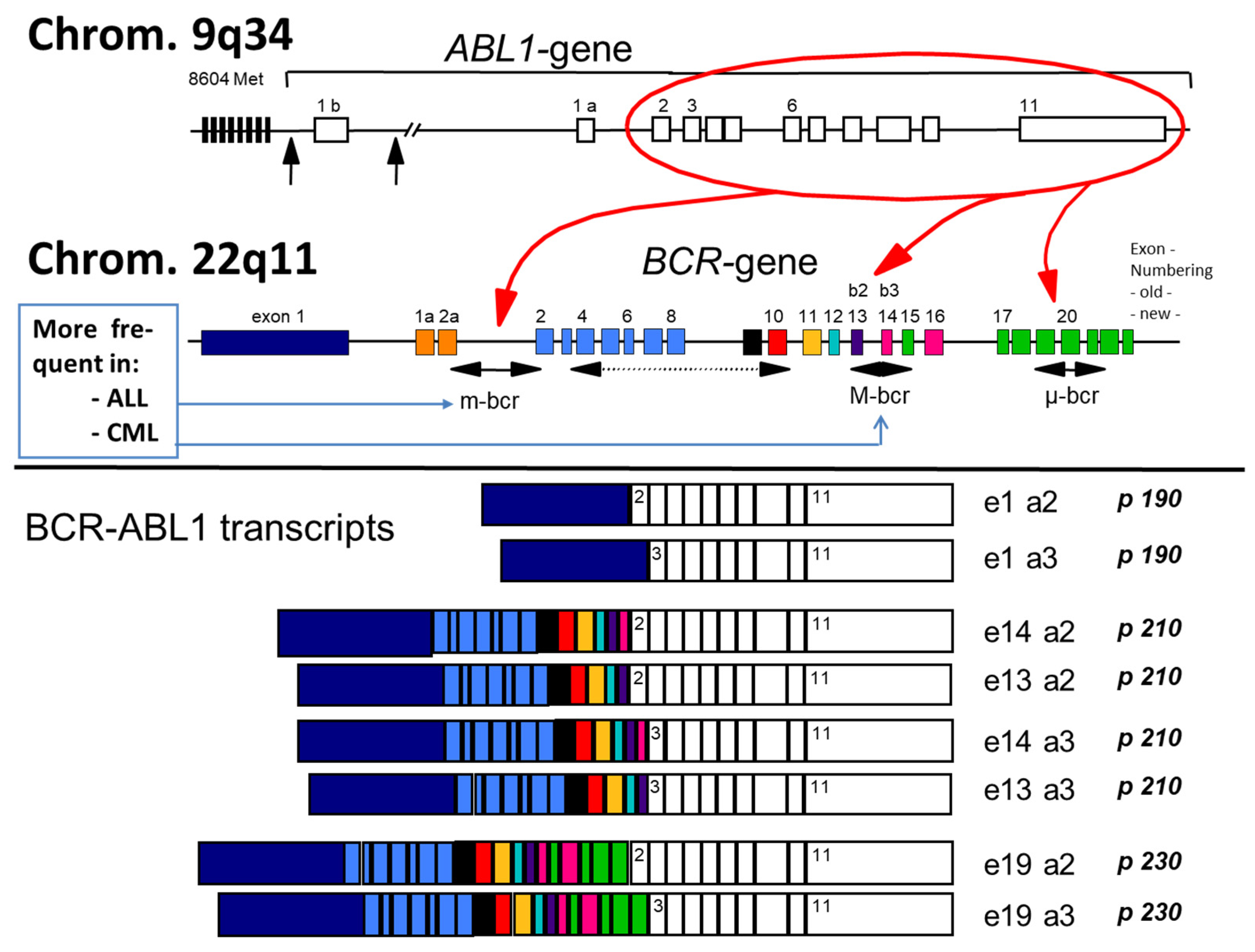
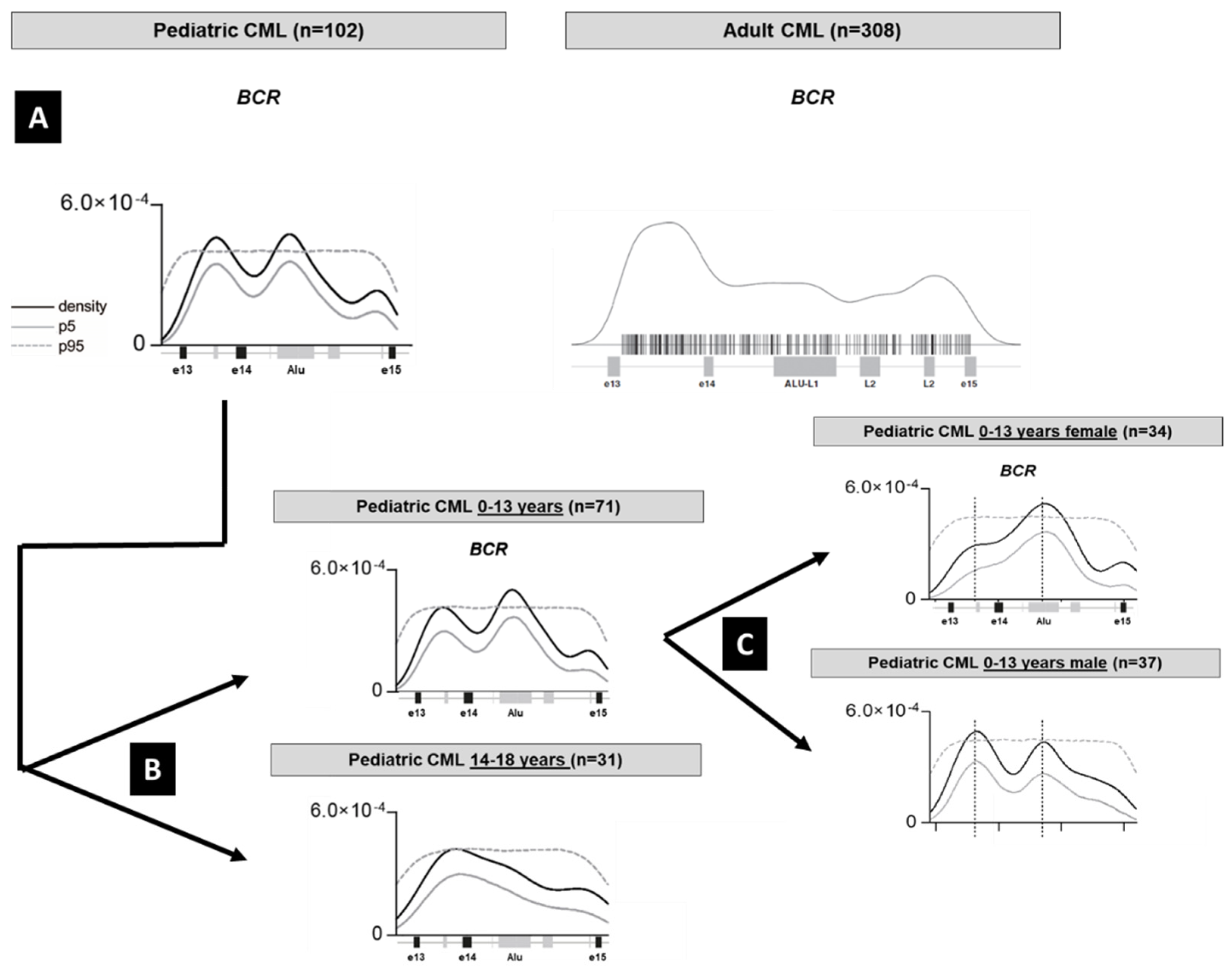
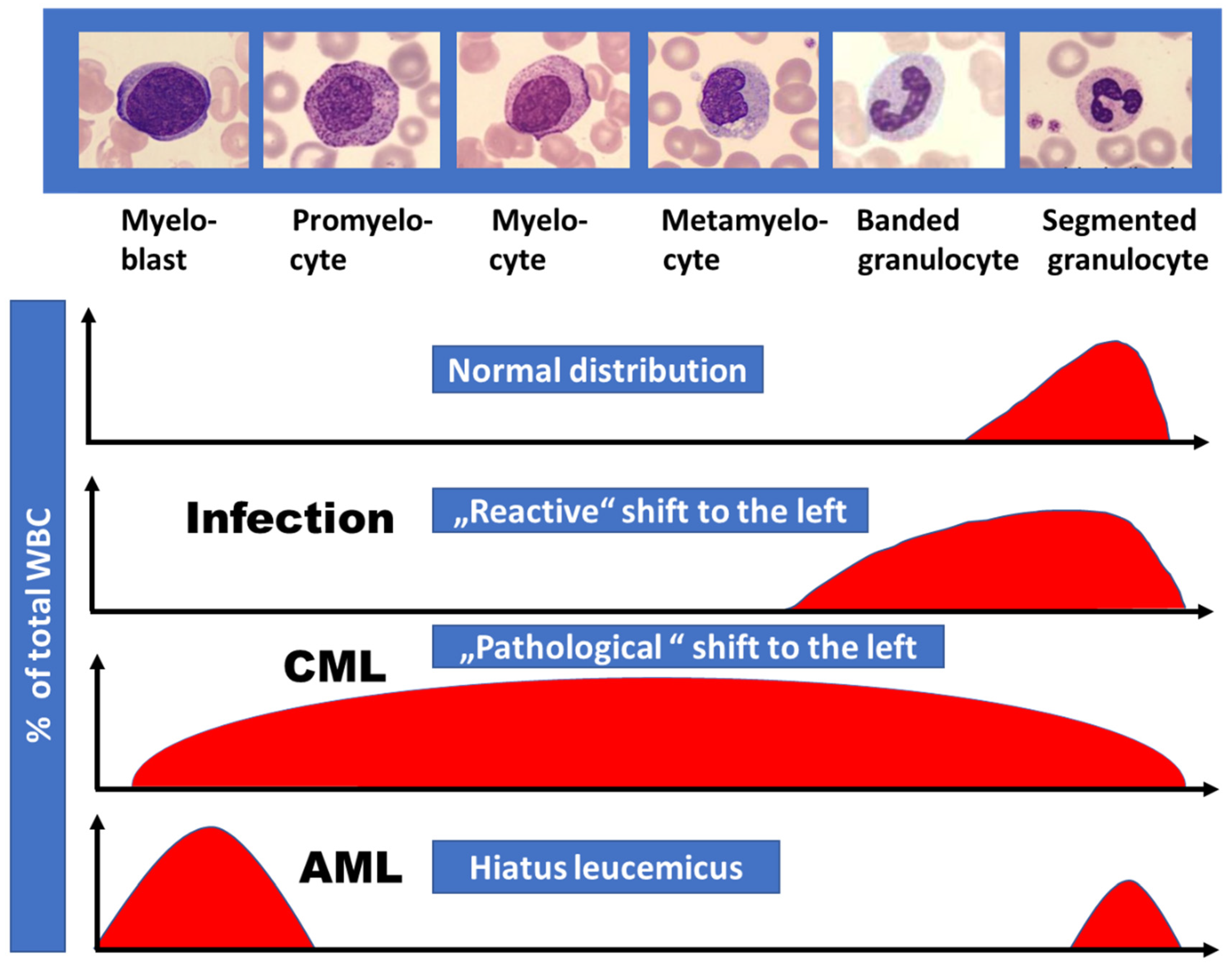
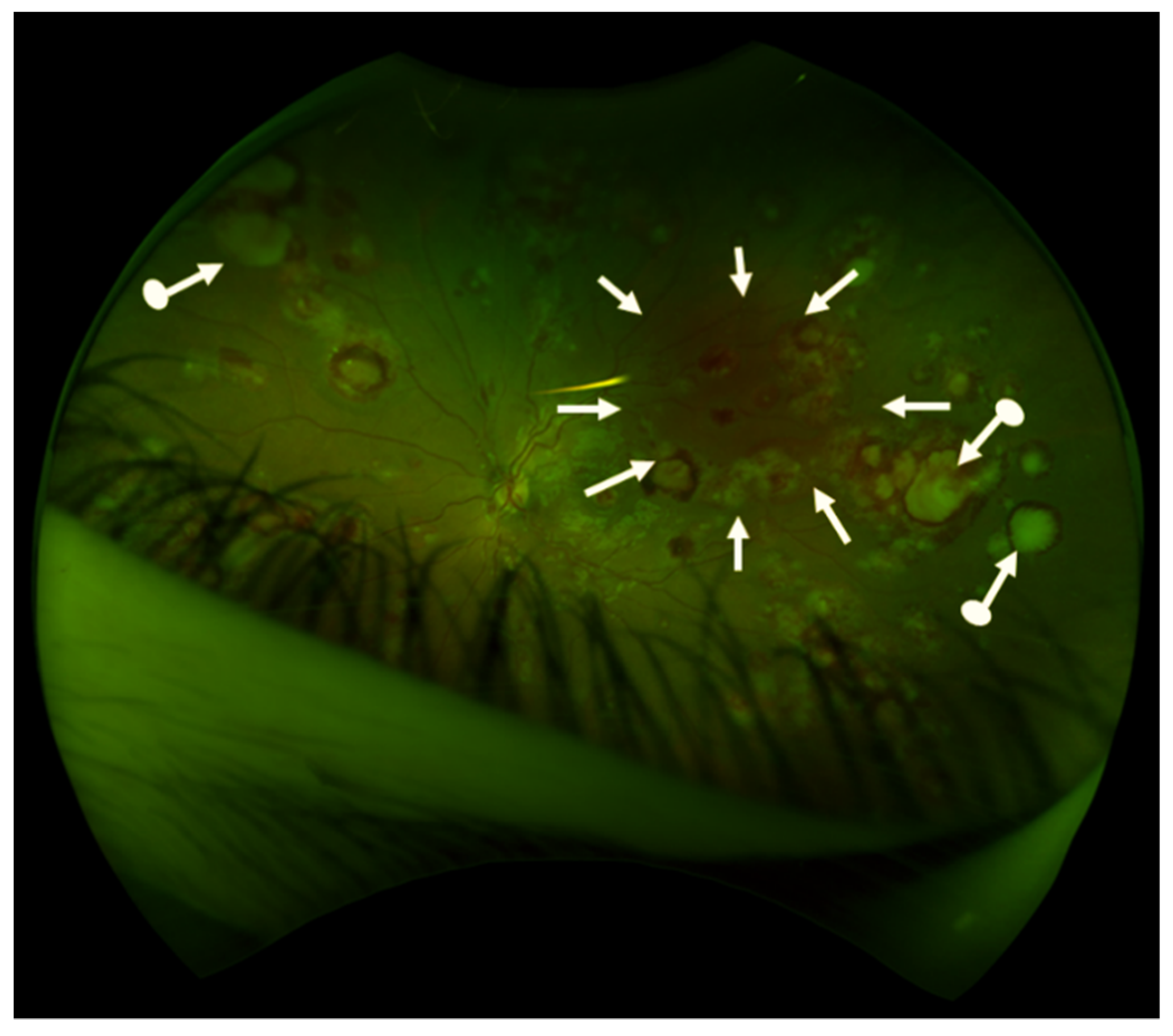
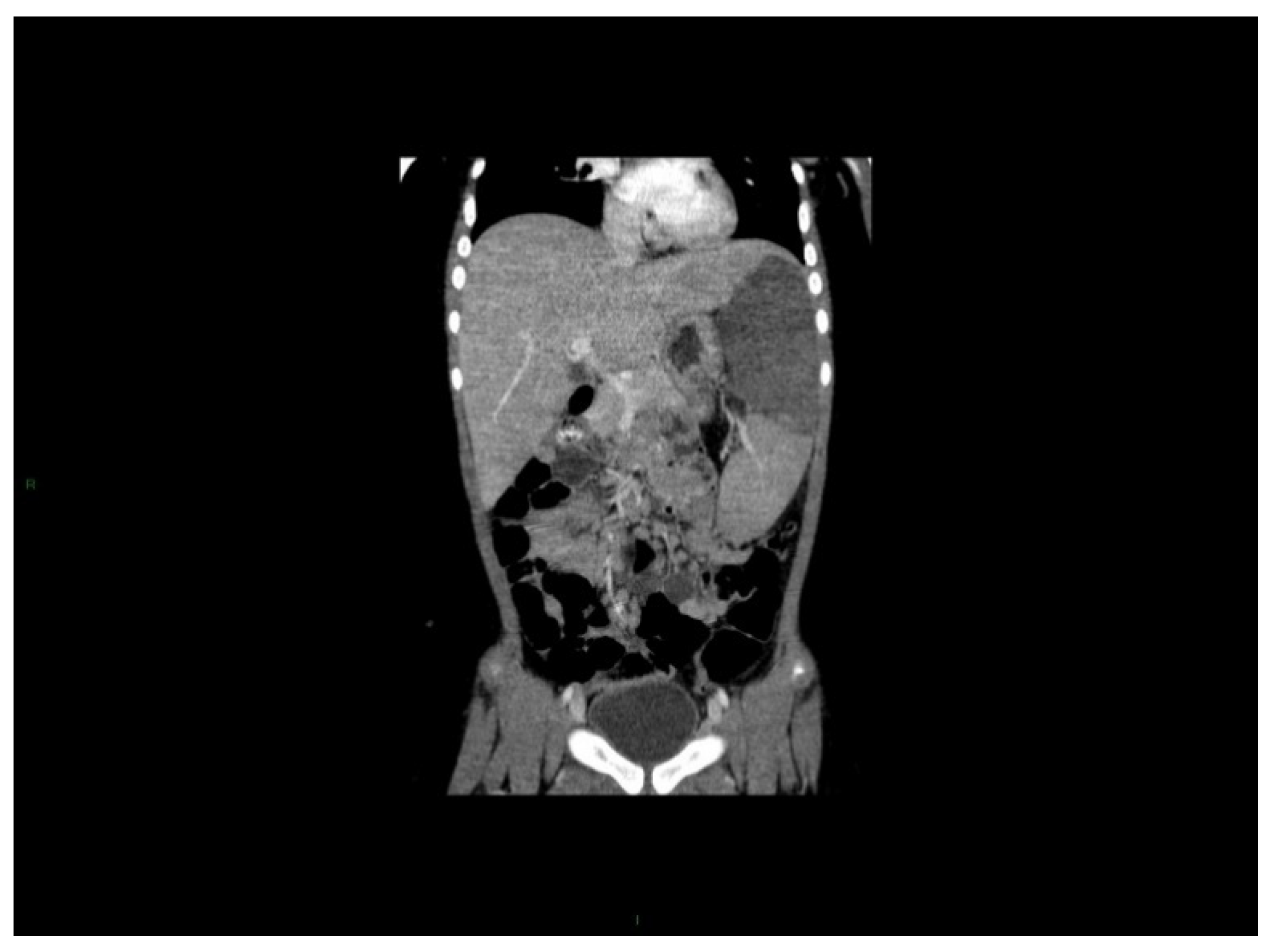
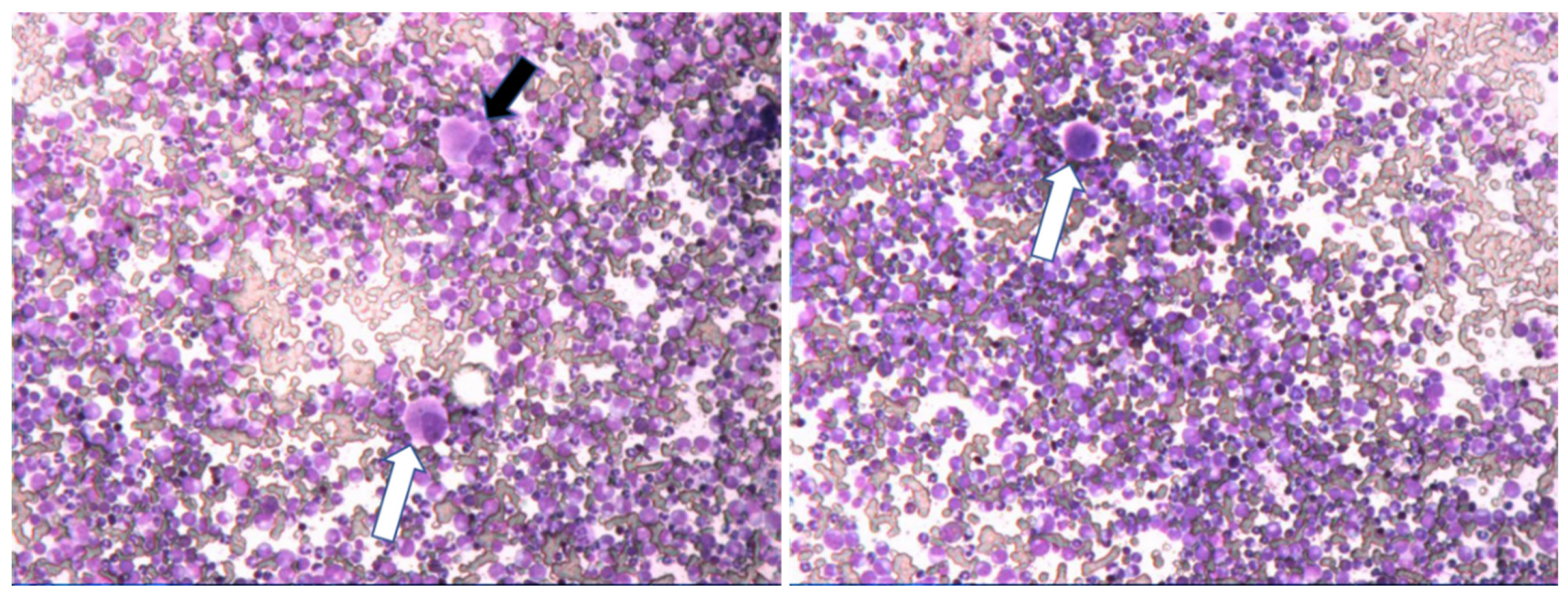
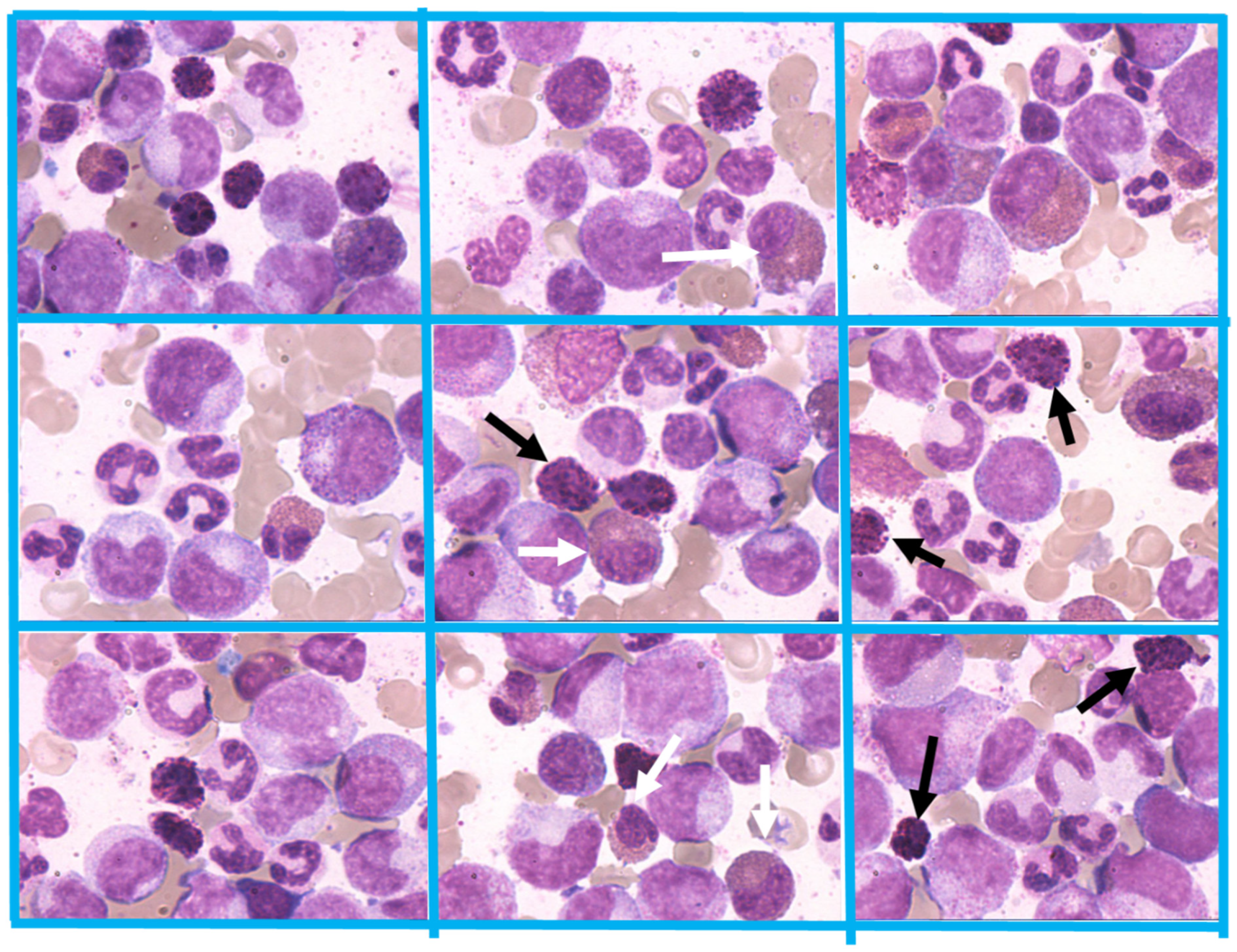
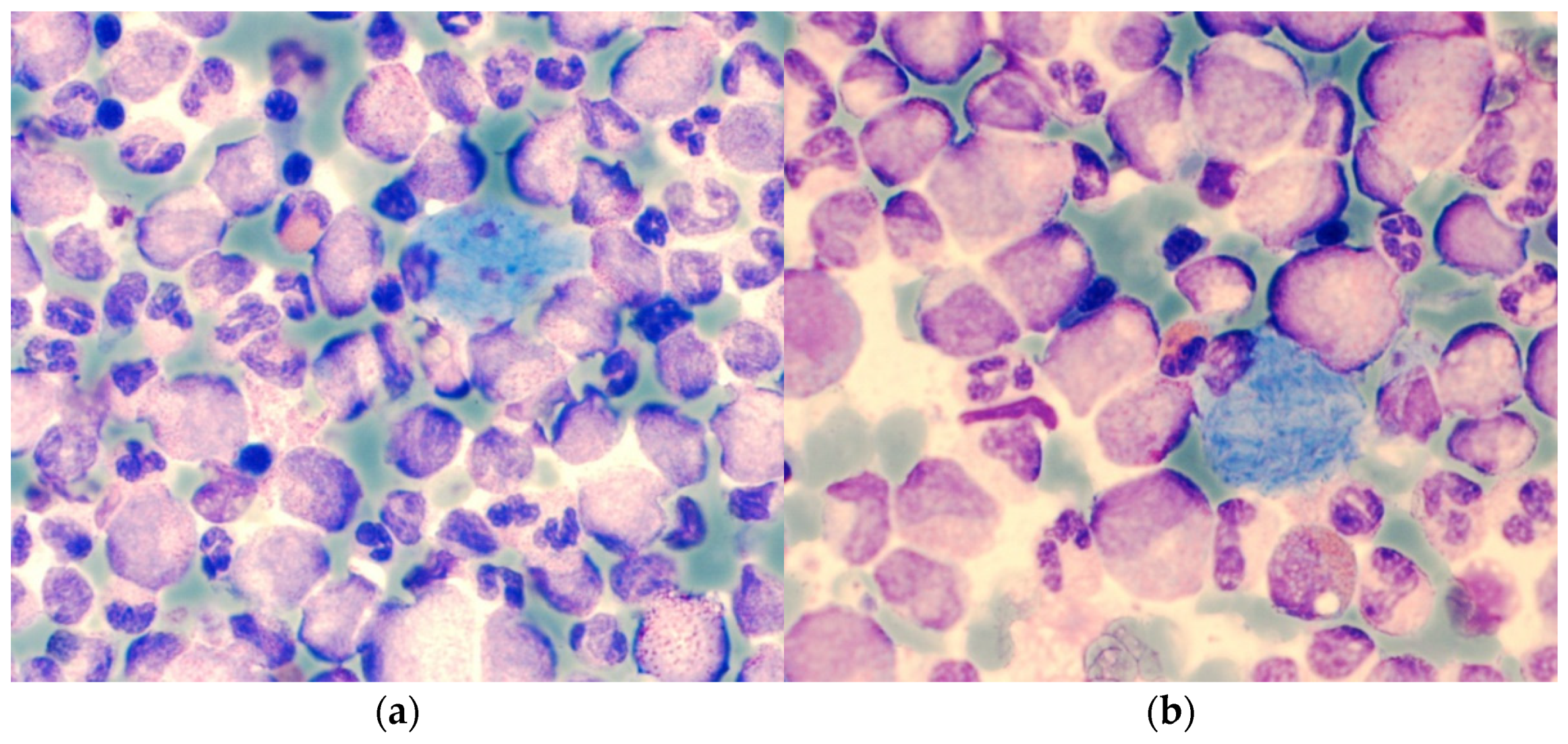
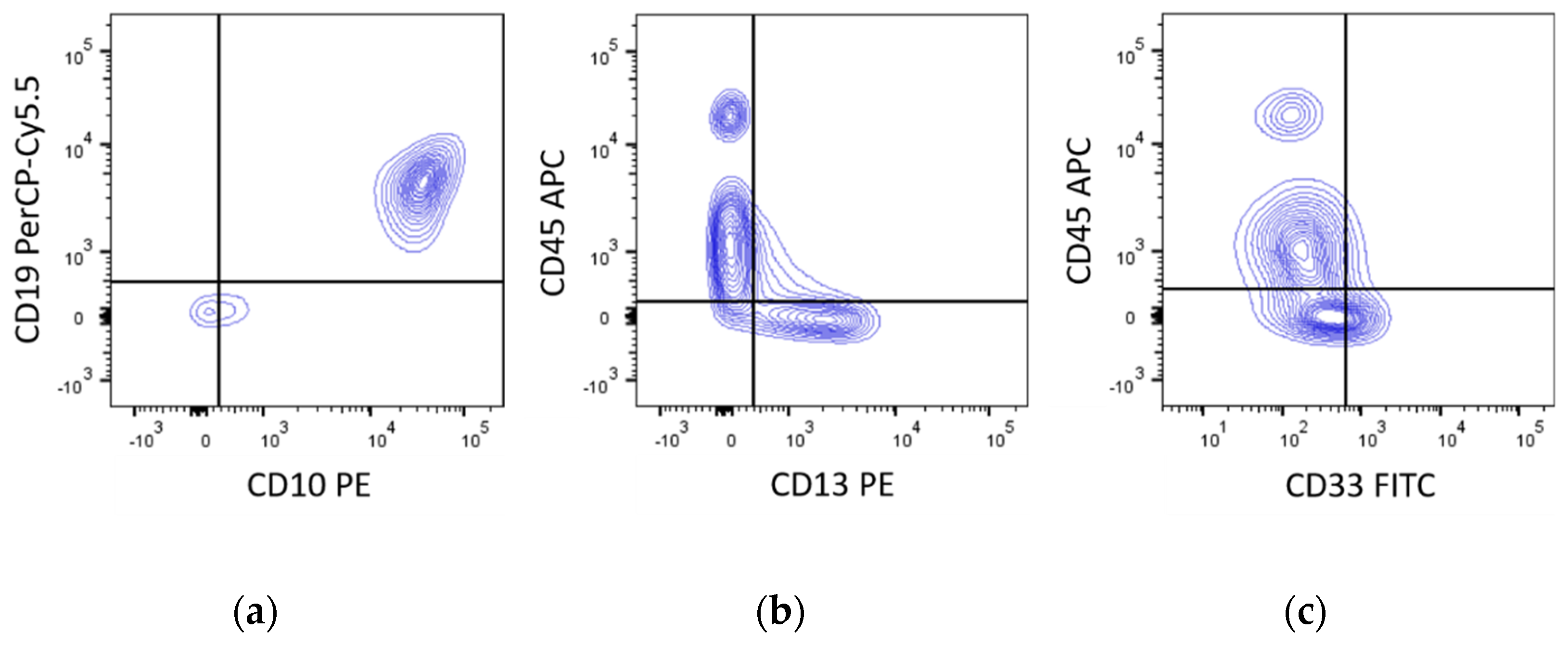
| Synonym | Abbreviation | Comment |
|---|---|---|
| CML, Philadelphia chromosome positive | CML, Ph1 chromosome+ | Nota bene: Ph1 stands for the word “Philadelphia” only * |
| CML, t(9;22)(q34;q11) | not applicable | |
| chronic granulocytic leukemia, BCR-ABL1 | CML, BCR-ABL1 | The abbreviation “CGL” should be avoided |
| chronic granulocytic leukemia, Philadelphia chromosome positive | CML, Ph1 chromosome+ | The abbreviation “CGL” should be avoided |
| chronic granulocytic leukemia, t(9;22)(q34;q11) | CML, t(9;22)(q34;q11) | The abbreviation “CGL” should be avoided |
| chronic myelogenous leukemia, BCR-ABL1 positive | CML, BCR-ABL1+ | - |
| chronic myelogenous leukemia, Philadelphia-chromosome positive | CML, Ph1 chromosome+ | - |
| chronic myelogenous leukemia, t(9;22)(q34;q11) | CML, t(9;22)(q34;q11) | - |
| ICD-11 Code | Category of CML | Comment |
|---|---|---|
| 2B33.2 | Chronic myeloid leukemia, not elsewhere classified | only to be designated in cases with incomplete diagnostics |
| 2A20.0Y | Other specified chronic myeloid leukemia, BCR-ABL1-positive | e.g., CML, BCR-ABL1-positive, in complete remission |
| 2A20.0Z | Chronic myeloid leukemia, BCR-ABL1-positive, unspecified | e.g., no information on the phase of CML |
| 2A20.00 | Chronic myeloid leukemia with blast crisis | - |
| 2A20.01 | Chronic myeloid leukemia, Philadelphia (Ph1) chromosome positive | - |
| 2A20.02 | Chronic myeloid leukemia, t(9:22)(q34;q11) | - |
| Definition as Used by | ||
|---|---|---|
| Phase | European LeukemiaNet (ELN) | World Health Organization (WHO) |
| CML CP |
|
|
| CML-AP |
|
|
| CML-BP |
|
|
| Age (Years) | 0–14 | 0–19 | <1 | 1–4 | 5–9 | 10–14 | 15–19 |
|---|---|---|---|---|---|---|---|
| Chronic Myeloproliferative Diseases | 1.4 | 2.1 | - | 0.7 | 1.0 | 2.1 | 4.3 |
Publisher’s Note: MDPI stays neutral with regard to jurisdictional claims in published maps and institutional affiliations. |
© 2021 by the authors. Licensee MDPI, Basel, Switzerland. This article is an open access article distributed under the terms and conditions of the Creative Commons Attribution (CC BY) license (http://creativecommons.org/licenses/by/4.0/).
Share and Cite
Suttorp, M.; Millot, F.; Sembill, S.; Deutsch, H.; Metzler, M. Definition, Epidemiology, Pathophysiology, and Essential Criteria for Diagnosis of Pediatric Chronic Myeloid Leukemia. Cancers 2021, 13, 798. https://doi.org/10.3390/cancers13040798
Suttorp M, Millot F, Sembill S, Deutsch H, Metzler M. Definition, Epidemiology, Pathophysiology, and Essential Criteria for Diagnosis of Pediatric Chronic Myeloid Leukemia. Cancers. 2021; 13(4):798. https://doi.org/10.3390/cancers13040798
Chicago/Turabian StyleSuttorp, Meinolf, Frédéric Millot, Stephanie Sembill, Hélène Deutsch, and Markus Metzler. 2021. "Definition, Epidemiology, Pathophysiology, and Essential Criteria for Diagnosis of Pediatric Chronic Myeloid Leukemia" Cancers 13, no. 4: 798. https://doi.org/10.3390/cancers13040798
APA StyleSuttorp, M., Millot, F., Sembill, S., Deutsch, H., & Metzler, M. (2021). Definition, Epidemiology, Pathophysiology, and Essential Criteria for Diagnosis of Pediatric Chronic Myeloid Leukemia. Cancers, 13(4), 798. https://doi.org/10.3390/cancers13040798






